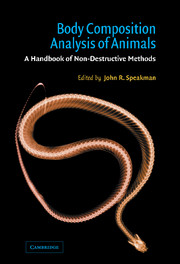Book contents
- Frontmatter
- Contents
- List of contributors
- Preface
- Acknowledgements
- Introduction
- 1 Morphological indicators of body condition: useful or wishful thinking?
- 2 Standard methods for destructive body composition analysis
- 3 The isotope dilution method for the evaluation of body composition
- 4 Gas dilution methods: elimination and absorption of lipid-soluble gases
- 5 The use of total body electrical conductivity (TOBEC) to determine body composition in vertebrates
- 6 The use of bioelectrical impedance analysis (BIA) for estimation of body composition
- 7 The assessment of body composition and other parameters by ultrasound scanning
- 8 The use of dual-energy X-ray absorptiometry for the measurement of body composition
- Index
3 - The isotope dilution method for the evaluation of body composition
Published online by Cambridge University Press: 19 January 2010
- Frontmatter
- Contents
- List of contributors
- Preface
- Acknowledgements
- Introduction
- 1 Morphological indicators of body condition: useful or wishful thinking?
- 2 Standard methods for destructive body composition analysis
- 3 The isotope dilution method for the evaluation of body composition
- 4 Gas dilution methods: elimination and absorption of lipid-soluble gases
- 5 The use of total body electrical conductivity (TOBEC) to determine body composition in vertebrates
- 6 The use of bioelectrical impedance analysis (BIA) for estimation of body composition
- 7 The assessment of body composition and other parameters by ultrasound scanning
- 8 The use of dual-energy X-ray absorptiometry for the measurement of body composition
- Index
Summary
Introduction
One key to measuring the body composition of an animal without killing it in the process is the fact that water is not evenly distributed in body tissues. Fat contains substantially less water than lean tissue and this difference means that the fatter an organism becomes, the lower the water content as a percentage of its total body mass. Since body mass is relatively easily measured, if the total water content of an animal could also be quantified, a method would be available for estimating fatness. Several of the methods detailed in this book (for example, TOBEC: Chapter 5 and BIA: Chapter 6) rely on the differential water contents of lean and fat tissue to quantify body composition. Dilution methods are also based on this principle. Initial attempts to measure the body water by dilution used compounds that were soluble in water (such as antipyrene: e.g. Soberman et al., 1949, urea: e.g. Meissner, 1976 or thiocyanate: e.g. Hollander et al., 1949). The discovery of isotopes of oxygen and hydrogen in the 1920s and 1930s had opened up the opportunity of using these materials to ‘label’ the body water directly, and the first attempts to do this were made in the 1930s (von Hevesy & Hofer, 1934). The isotope dilution method grew out of these initial studies.
Theory
To understand how the isotope dilution method works, it is perhaps useful to consider an analogous situation with which many animal ecologists will be familiar: the problem of determining the size of a population of animals that live in a given area.
- Type
- Chapter
- Information
- Body Composition Analysis of AnimalsA Handbook of Non-Destructive Methods, pp. 56 - 98Publisher: Cambridge University PressPrint publication year: 2001
- 34
- Cited by

